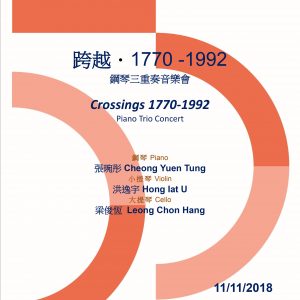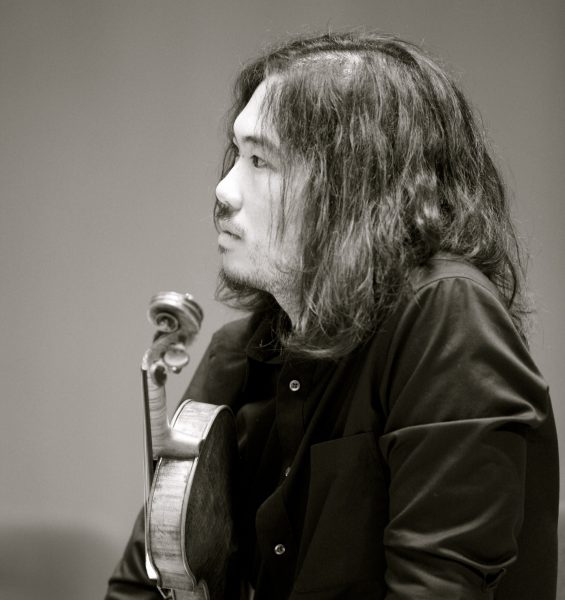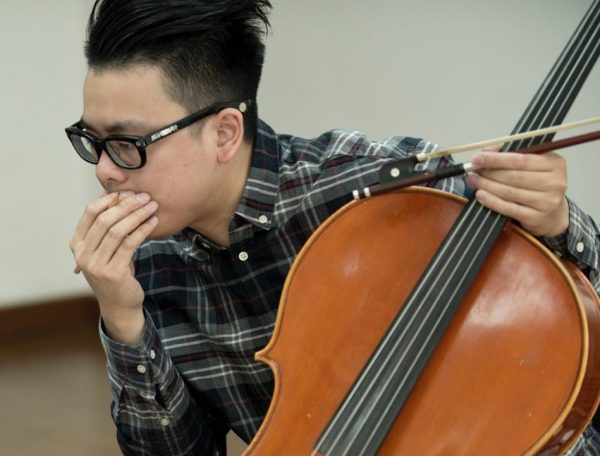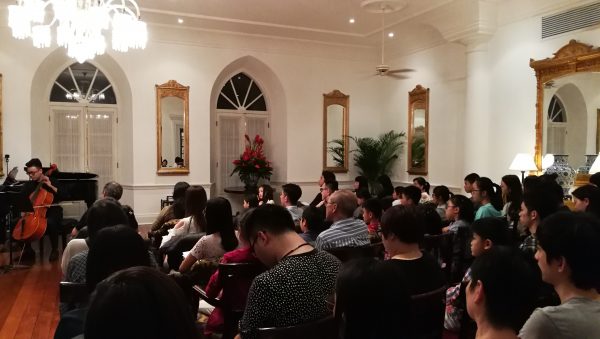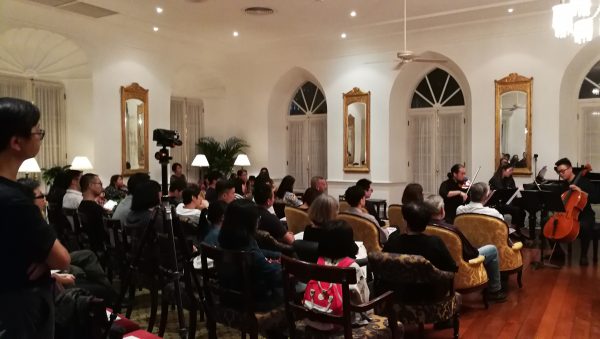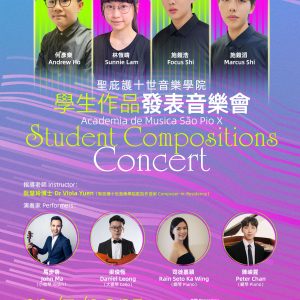聖庇護十世音樂學院五十五周年慶典系列活動
《跨越.1770 - 1992》鋼琴三重奏音樂會
聖庇護十世音樂學院五十五周年慶系列活動自本年六月起便舉行了十場音樂會及兩場音樂創作講座,系列活動中最後一場《跨越.1770-1992》鋼琴三重奏音樂會將於11月11日(星期日)下午六時假陸軍俱樂部舉行。
《跨越.1770-1992》鋼琴三重奏音樂會,由聖庇護十世音樂學院校友及鋼琴導師張琬彤,攜同本澳兩位青年演奏家洪逸宇(小提琴)及梁俊恆(大提琴)演奏。三位演奏者合作無間,是次音樂會將呈獻多首鋼琴三重奏曲的經典曲目,包括貝多芬G大調第二號鋼琴三重奏作品1、勃拉姆斯C小調第三號鋼琴三重奏作品101及皮亞佐拉的布宜諾斯艾利斯《四季》選段。
張琬彤曾多次在澳門青年音樂比賽中獲獎,並於2005年考入中央音樂學院附中,期後畢業於北京中國音樂學院鋼琴系鋼琴演奏專業;2011年於澳門理工學院舉行個人獨奏音樂會,廣受好評。張氏近年活躍於本地音樂演出,參與多個大小演出及與多個本地協會合作。小提琴手洪逸宇於2005年考取中央音樂學院附中,2011年畢業於中央音樂學院。在學期間參與中國青年交響樂團演出,以及由著名作曲家譚盾所帶領於上海世界博覽會之演出活動。自2013年起一直擔任音樂作品《墓所事事》的小提琴樂手,隨團參與於愛丁堡、葡萄牙、北京、廣州、台灣、日本、韓國等地之巡演。大提琴手梁俊恆2014年畢業於香港演藝學院修讀大提琴,並取得音樂學士(榮譽)學位。曾考獲荷蘭NJO Summer Academy,參加本地及外地音樂比賽,並屢次獲獎。最近,梁氏有幸獲選參加廣東國際青年音樂周YMCG2018,得到馬友友和他的絲路樂團指導,在演奏上得到更深的啟發。
音樂會免費入場,歡迎音樂愛好者出席。查詢請於辦工時間內:逢星期一至五下午三時至晚上八時及星期六上午九至中午一時致電28355654。
節目表
Programme
貝多芬:G大調第二號鋼琴三重奏,作品1
Beethoven: Piano Trio in G major, Op.1, No.2
慢板−活潑的快板
Adagio – Allegro vivace
表情豐富的慢板
Largo con espressione
諧謔曲,快板
Scherzo, Allegro
终曲,急板
Finale, Presto
勃拉姆斯:C小調第三號鋼琴三重奏,作品101
Brahms: Piano Trio in C minor, Op.101, No.3
強而有力的快板
Allegro energico
不很急的急板
Presto non assai
典雅的行板
Andante grazioso
很快的快板
Allegro molto
皮亞佐拉:《布宜諾斯艾利斯的四季》選段 “夏天"及“冬天"
Piazzolla: “Summer” and “Winter” from The Four Seasons of Buenos Aires
鋼琴Piano:張琬彤 Cheong Yuen Tung
小提琴Violin:洪逸宇 Hong Iat U
大提琴Cello:梁俊恆 Leong Chon Hang
演奏者簡介 Performers
張琬彤 Cheong Yuen Tung(鋼琴Piano)
畢業於北京中國音樂學院鋼琴系鋼琴演奏專業,師從傅紅副教授。自幼在聖庇護十世音樂學院跟隨梁官流老師學習鋼琴,亦曾隨前澳門樂團首席、現中國愛樂樂團首席陳允教授學習小提琴, 以及跟隨中國女高音歌唱家楊潔老師學習聲樂。張氏曾多次在澳門青年音樂比賽中獲獎。2005年畢業於陳瑞祺永援中學並入讀中央音樂學院附中,師從美國鋼琴家 Tara Hofmeister。2011年8月於澳門理工學院舉行個人獨奏音樂會,廣受好評,同年9月起為聖庇護十世音樂學院鋼琴教師,近年活躍於本地音樂演出,參與多個大小演出及與多個本地協會合作,2015年起任教於澳門浸信中學。
Macao pianist Cheong Yuen Tung studied at the China Conservatory of Music Beijing with Professor Fu Hong. She started learning the piano with Mr. Leong Kun Lao at the Academia de Música S. Pio X at the age of 7. She also studied the violin with Pro. Chen Yun, the concert master of China Philharmonic Orchestra, and voice with Yang Jie. She has won several awards in the Macau Youth Musicians Competition. In 2005 she was accepted into the High School of the Beijing Central Conservatory of Music under the tutelage of American pianist Tara Hofmeister. Her solo recital in 2011 at the Macao Polytechnic Institute was well received. She currently teaches the piano at the Academia de Música S. Pio X and at Macao Baptist College.
洪逸宇Hong Iat U(小提琴Violin)
生於澳門,師從陳允教授、謝楠教授。1996年起在澳門演藝學院學習小提琴,曾多次參加澳門文化局舉辦的音樂比賽,屢獲榮譽及優異奬項。2005年考取中央音樂學院附中,2007年考取中央音樂學院並於2011年畢業。在學期間參與中國青年交響樂團演出,跟隨樂團赴韓國參加交響音樂節,以及由著名作曲家譚盾所帶領於上海世界博覽會之演出活動。2011年4月以個人名義獲邀參加跨界藝人范憶堂《浮生。繪》於台灣之巡演。2012年第二十三屆及2013年第二十四屆澳門藝術節亦以個人名義參加多個演出。2014年10月受邀參加自由探戈樂團在中國各地音樂節演出。2015年3月參演《明心反照》。自2013年第二十四屆澳門藝術節起一直任《墓所事事》(此作品由聖庇護十世音樂學院校友楊光奇作曲)小提琴樂手,並參與於愛丁堡、葡萄牙、北京、廣州、台灣、日本、韓國等地之巡演。在學期間均獲澳門文化局及澳門基金會頒發之獎學金。
Hong Iat U was born in Macao. He studied violin performance at the Macao Conservatory from 1996 to 2005 during which time he won many prizes in music competitions organized by the Macao Cultural Affairs Bureau. He went on to study with professors Chen Yun and Xie Nan at the Central Conservatory of Music in Beijing and graduated in 2011. He was awarded scholarships from both the Macao Cultural Affairs Bureau and Macao Foundation to pursue his studies. Hong toured Korea and performed in the Shanghai Expo as a member of the Chinese Youth Orchestra. He toured Taiwan with crossover musician Fan E Tang in 2011. Subsequently, he performed in the 23rd and 24th Macao Arts Festival and in 2014 was invited to join the Tango Libertad group performance tour in China. He has been a performer in the concert theatre piece Picnic in the Cemetery (created by Academia de Música S. Pio X alumna Ngo Kong Kie) since 2013 and has toured with the production to a dozen cities worldwide.
梁俊恆Leong Chon Hang(大提琴Cello)
自幼熱愛音樂,並展開其音樂生涯。2014年畢業於香港演藝學院修讀大提琴,師承王磊教授,並取得音樂學士(榮譽)學位。參加過多個大師班,包括王健、Francios Salque、Bion Tsang、李繼武、朱亦兵、秦立魏、俞明清等。曾考獲荷蘭NJO Summer Academy,參加本地及外地音樂比賽,並屢次獲獎。此外也參與本地與外地團體之演出,包括澳門樂團、澳門中樂團、香港電台弦樂四重奏、深圳交響樂團等。梁氏熱衷於音樂及致力推動音樂教育工作,從大學開始已投入教學,擁有豐富教學及表演經驗,其學生在本地及外地考試或比賽中取得很好的成績。最近,梁氏有幸獲選參加廣東國際青年音樂周YMCG2018,得到馬友友和他的絲路樂團指導,在演奏上得到更深的啟發。
Leong Chon Hang, developed an interest in music from an early age. He studied at the Hong Kong Academy for Performing Arts under Professor Ray Wang, graduating with Bachelor of Music (Honours) Degree in 2014. He has attended masterclasses by famous cellists such as Yo-Yo Ma, Wang Jian, Mike Block, Francios Salque and Bion Tsang. He was selected to participate in the Nationaal Jeugd Orkest (National Youth Orchestra of the Netherlands) Summer Academy in August 2011. He has won many awards in competitions, including second prize in the “The Second Aegean Sea Cup Cello Competition” in Beijing in 2006. He plays regularly in orchestras such as the Macao Orchestra, the Macao Chinese Orchestra, Radio Television Hong Kong String Quartet and the Shenzhen Symphony Orchestra. In January this year, he was chosen to attend the Guangzhou Young Musicians Week YMCG2018, during which he studied improvisation with Yo-Yo Ma and The Silk Road Ensemble.
曲目介紹
Programme Notes
貝多芬:G大調第二號鋼琴三重奏,作品1
慢板−活潑的快板
表情豐富的慢板
諧謔曲,快板
终曲,急板
這首G大調第二號鋼琴三重奏是貝多芬於維也納跟隨海頓學習期間的創作,形式上並沒有使用當時三重奏的傳統(只有二至三個樂章),而是採用了海頓《倫敦交響曲》四樂章的形式。當時傳統的三重奏慣常有一領奏樂器,其餘的樂器則作為領奏樂器的伴奏,但貝多芬所創作的三重奏更着重於三件樂器的均衡使用,小提琴和大提琴均擁有自己的聲部和旋律。第一樂章序奏部分採用幻想曲風格,而主部的快板則採用了奏鳴曲式。在第二樂章,大提琴和小提琴以平靜的應答方式出現,並省去了發展部,而再現部的變奏手法描寫得非常細致。第三樂章以諧謔的主題於各聲部逐漸發展,中間部利用此主題反向進行,中段音樂是各部反覆的兩段體,中段結束後再重新敘述諧謔主題。第四樂章採用奏鳴曲式,結構較大,全樂章洋溢着明朗的氣氛。
Beethoven: Piano Trio in G major, Op.1, No.2
Adagio – Allegro vivace
Largo con espressione
Scherzo, Allegro
Finale, Presto
This piano trio was composed during the time when Beethoven was studying with Haydn in Vienna. Unlike the traditional trio that contains two or three movements, this one has four movements, according to the form of Haydn’s ‘London’ Symphony. Moreover, the composer emphasized a more balanced use of the three instruments, which differed from previous trios that usually have a leading instrument and the other two instruments having a less prominent role. The introduction of the first movement is written in a fantasia style, with the main section in sonata form. This is followed by a calm conversation between the violin and the cello in the second movement. There is no development, but the recapitulation is a delicate variation of the opening. The scherzo third movement has a theme that is developed in each voice. The Trio section utilizes the same theme but in a reverse direction. The Trio has two parts, each repeated before the return of the opening theme. The final movement, in extended sonata form, is filled with brightness and brilliance.
勃拉姆斯:C小調第三號鋼琴三重奏,作品101
強而有力的快板
不很急的急板
典雅的行板
很快的快板
這是勃拉姆斯處於創作高峰時期的作品,於1886年當他在瑞士霍夫斯特滕避暑期間撰寫的。第一樂章,奏鳴曲式,以熱情有力的主題動機貫徹全曲,發展部弦樂以對位法,在多重色彩的背景下以對位展開,與第二主題交叉形成極嚴謹的結構。第二樂章,三段體,有諧謔性格,後段鋼琴不斷奏出給人以鄉愁感的和弦,而弦樂又配以熱情而帶幾分戲謔的句子。第三樂章,三段體,帶有民歌風格,節奏錯綜複雜,旋律卻優美而單純,中段小提琴和鋼琴的對話異常清新。第四樂章,奏鳴曲式,小提琴開頭奏出有諧謔風格的旋律,至經過部速度改變,將柔美而又鄉愁般的另一主題突顯出來,發展部恢復原速度,諧謔風格的旋律再現後,給予歡樂的性格而結尾。
Brahms: Piano Trio in C minor, Op.101, No.3
Allegro energico
Presto non assai
Andante grazioso
Allegro molto
This piece is composed in 1886, the most active period of Brahms’s composition life, during his summer vacation in Hofstetten, Switzerland. The first movement Allegro energico is written in sonata form, with the powerful theme’s motives appearing throughout the movement. In the development section, the strings are developed in contrapuntal style, and crossed over with the second theme into a close-knit structure. The second movement Presto non assai has a scherzo character, written in tertiary form. The third movement Andante grazioso is like a folksong, having complex rhythms but pure and beautiful melodies. The interplay between the violin and the piano in the middle part is particularly striking. The final movement Allegro molto begins with a humorous melody in the violin, this is contrasted with a gentle and nostalgic theme brought forth from the tempo change in the transition section. The humorous melody appears again after the development section at the original tempo, and leads to a joyful ending.
皮亞佐拉:《布宜諾斯艾利斯的四季》選段 “夏天"及“冬天"
《布宜諾斯艾利斯的四季》在開始時只有“夏天”,皮亞佐拉並沒有寫四季的計畫。布宜諾斯艾利斯的夏天本來是為舞台劇 Melenita de oro 所寫的四首音樂之一。1965年皮亞佐拉接到為這舞台劇寫音樂的委託之後,一直到要錄音的前一天晚上,一夜之間譜寫包括這首“夏天"的四首音樂。1969前半年他完成“秋天”,1970年完成“冬天”與“春天”。皮亞佐拉的《四季》,是把他故鄉阿根廷布宜諾斯艾利斯的四個季節放在音樂裡彙集而成,其架構與韋瓦第的《四季》一樣,只是皮亞佐拉的故鄉位於南半球,一年之始為夏天,因此也從夏天開始。
Piazzolla: “Summer” and “Winter” from The Four Seasons of Buenos Aires
Initially there is only the “Summer” movement in The Four Seasons of Buenos Aires, and Piazzolla did not intend to write music for all four seasons. He was commissioned to write music for the play Melenita de oro in 1965, and completed four pieces in the night just before the recording, “Summer” being one of the pieces. He later finished “Autumn” in the first half of 1969, and “Winter” and “Spring” were completed in 1970. Piazzolla’s Four Seasons are derived from the tango rhythms of his hometown Buenos Aires, and its structure is similar to Vivaldi’s Four Seasons except that the city is located in the south hemisphere where the new year begins with summer and not spring.
鳴謝 Acknowledgements
陸軍俱樂部
Clube Militar de Macau

